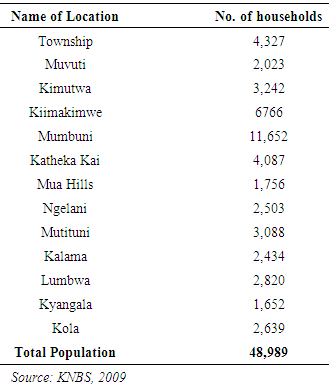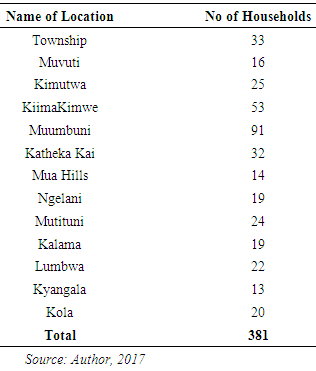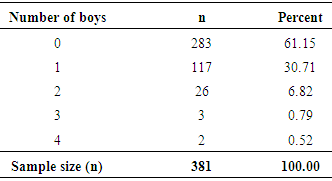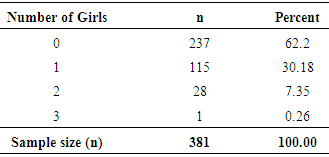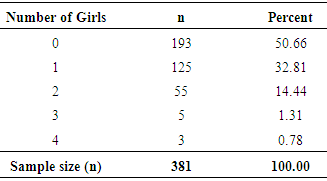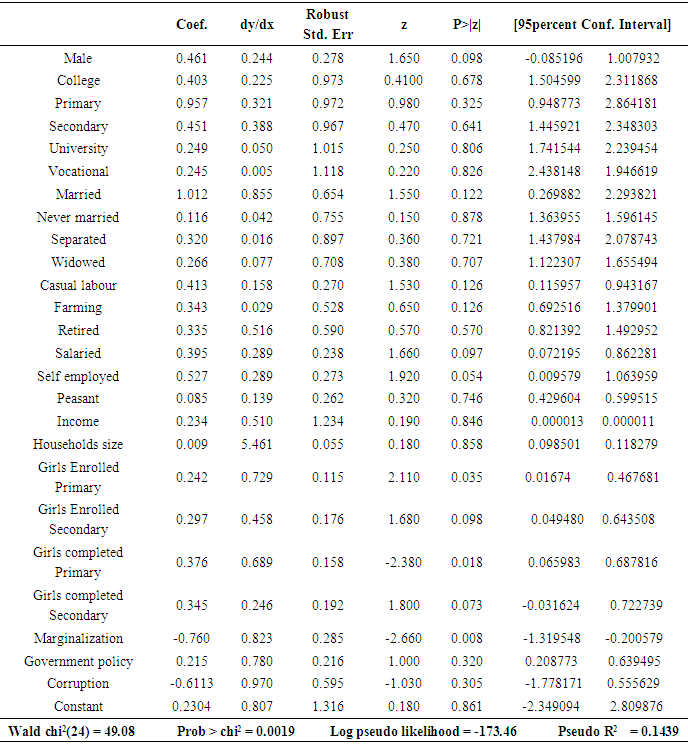-
Paper Information
- Paper Submission
-
Journal Information
- About This Journal
- Editorial Board
- Current Issue
- Archive
- Author Guidelines
- Contact Us
Microeconomics and Macroeconomics
p-ISSN: 2168-457X e-ISSN: 2168-4588
2018; 6(1): 9-19
doi:10.5923/j.m2economics.20180601.02

Effect of Gender Empowerment Programmes on Improving Quality of Life in Kenya: Evidence from Machakos County
Joshua M. Ngelu, Jane Omwenga, Joseph Mungatu, Mike Iravo
College of Human Resource Development, JKUAT, Nairobi, Kenya
Correspondence to: Joshua M. Ngelu, College of Human Resource Development, JKUAT, Nairobi, Kenya.
| Email: |  |
Copyright © 2018 Scientific & Academic Publishing. All Rights Reserved.
This work is licensed under the Creative Commons Attribution International License (CC BY).
http://creativecommons.org/licenses/by/4.0/

This study investigates the effect of gender empowerment programmes on improving quality of life in Kenya: evidence from Machakos County. Probit model is used to model the empirical analysis. The findings are that generally all the households sampled recorded higher completion rates for girls than boys in primary school while in secondary school the completion rate was higher for boys than that of girls. Regression results indicate that primary and secondary school enrolment of the girl child is more likely to improve the quality of the household’s life by 0.7292 and 0.4584 respectively chances as compared to not enrolling. The results posit that a household with a girl child who successfully completes primary and secondary school education is more likely to have an improved quality life by 0.6890 and 0.2466 chances respectively as compared to a household with girl child who fails to successfully complete her primary school education. However it is noted that girl child enrolment in primary school has the highest impact.
Keywords: Gender Empowerment programmes, Quality of life, Probit model
Cite this paper: Joshua M. Ngelu, Jane Omwenga, Joseph Mungatu, Mike Iravo, Effect of Gender Empowerment Programmes on Improving Quality of Life in Kenya: Evidence from Machakos County, Microeconomics and Macroeconomics, Vol. 6 No. 1, 2018, pp. 9-19. doi: 10.5923/j.m2economics.20180601.02.
Article Outline
1. Introduction
- Gender empowerment programmes are increasingly becoming a cornerstone of anti-poverty efforts in many developing countries. It can be noted that the recent interest in improving the lot of women in developing countries, culminating in the Cairo Population conference of 1994 and the Women's conference of 1995 in China, has led international agencies and feminist organizations alike to rally behind the concept of "women's. While schooling and work have always been at the centre of theoretical arguments as well as existing research on women and change, the extra step linking them to women's empowerment has been a part of empirical analyses (Mason, 1986) This has been the case partially because a systematic specification on various aspects of empowerment is lacking and partially because measures of women's domestic or social power are usually absent from vast majority of sociological, economic, or demographic surveys conducted in developing countries. In fact, in many empirical studies addressing issue, the tautology has been so complete that education and employment themselves have served as the most frequent proxy measures for women's position, status, or autonomy (Bradley and Khor, 1993).According to Blumberg, (1984), Collins et al., (1993), Ferree (1990) and Goode (1963) the perceived centrality of education in improving women's position and incomes within the recent historical experience of gender systems also has been a major reason why feminist and development theories have implied the existence of a similar relationship in non-Western societies. This presumption that resources serve as key empowering agents for women in developing countries, has been questioned less often than it ought to have been. The focus on women's empowerment is motivated by its centrality in theoretical, political, and policy forums as an essential means toward not only facilitating development, but also toward rectifying gender inequalities and granting women throughout much of the world the basic human rights and life options generally more easily accessible to men. Clearly, how much power men hold also is affected by resources and the larger sociocultural context, although the gendered nature of most societies is likely to mean that this relationship is fundamentally different for them when compared with women. By definition, however, a gendered context also means that neither male nor female power can be examined entirely in isolation. Thus, while the explicit focus is women, aspects of male power are also inherently and implicitly built into this inquiry as will be clearly illustrated by our theoretical discussion and empirical measures.The need to "empower" women in developing countries so that gender inequalities will be reduced, socioeconomic conditions will improve, and population growth will subside is now common rhetoric. However, despite its strong and forceful incorporation in international documents and plans, the concept of gender empowerment remains vague. At best, the rhetorical use of empowerment implies only broad-based, active means for facilitating women to have greater personal control over their lives. However, there is no exact specification on what aspects of power are most relevant, but also to recognize the complexities inherent in the concept of power in its relevance to gender relations (Department of State, 1995; United Nations, 1994).A number of scholars have studied the role of gender equality and women’s empowerment in reducing poverty and stimulating economic growth. Morrison, Raju, & Sinha (2007) proved that the impact of women’s rights and decision-making power in families helped reduce poverty and improve productivity at per person and family levels. In addition, they showed the relationship between gender equality and poverty reduction and economic growth at the macro level. Özpolat and Yıldırım (2009) investigated the relationship between the education of women and economic growth by analyzing the economic dimension of women’s education.Schultz (1961) who was the first economist in this area, studied the difference in worker productivity by gender, based on their work experience and schooling. Becker and Thomes (1994) also indicated that different wages among workers was in line with the difference in their education level, training, and work experience. Bourguignon and Morrison (2002) examined how higher education levels lead to lower fertility rates by affecting per capita income growth and decreasing mortality rate per child. Barro (1991) revealed that more educated households are likely to have higher productivity than more children; this shows that education and fertility rate have a negative effect on each other. Baden and Green (1994) however argued that women’s education is not the main factor for improved child health and welfare and reduced fertility, and that it is more effective to spend directly on child health and family planning to reduce fertility and child mortality instead of investing in educating women. Dollar and Gatti (1999) also studied the relationship between gender inequality in education and economic growth. They explained the positive relationship between the education of women and economic growth by using a five-year growth interval and by controlling for possible endogeneity among education and economic growth with the help of instrumental variable estimation. Klasen and Lamanna (2008) also investigated the impact of gender inequality in education and employment on economic growth in developing countries through a 41-year period (1960–2000). Klasen and Lamanna (2008) revealed that gender inequality in education and employment can reduce economic growth, and also stated that reducing gender inequality would lead to economic development because the education of women has a huge impact on fertility and the creation of human capital for the next generation.Olaniyan, D.A and Okemakinde, T, (2008), expound on human capital theory as the theoretical framework most responsible for the wholesome adoption of education and development policies. Becker, G (1993), define human capital as “the stock of knowledge, habits, social and personality attributes, including creativity, embodied in the ability to perform labour so as to produce economic value. Human capital theorists use various methods to corroborate these views. First, they examine employee wages by comparing workers’ education levels. Using the “normal” assumptions of competitive labour and goods markets, human capital theorists conclude that education levels not only help workers acquire skills for better productivity, but also encourage them to improve their abilities and attain greater earning power. Correspondence theory of education also provides numerous implications for poverty reduction policies as it is an effective anti-poverty strategy that should be included in education and skills training especially among poor households. Studying data from rural China, Brown (2006) concluded that the education of mothers—compared to that of fathers—has a higher effect on the investment on education for their children. Thomas (1994) also found that the education of daughters is largely affected by the education of mothers, while the education of fathers has a significant effect on the education of sons.Endalcachew (2016) finds that the role of women across different dimensions of sustainable development is less reflected in the country with male dominance being clearly evidenced in all sectors of the economy. The study calls women empowerment and the need to uphold gender equality to enable women play their role in economic, social, political, and environmental areas failure to which the country will not achieve sustainable development with the recognition of only men's participation in all these areas.Surjonoa et al (2015) conclude that gender equality is significant to social capital in Indonesia. They prescribe that if development paradigm in Indonesia is based on social capital, then gender development should be an integral focus when it comes to national development. It can be noted that eradication of poverty was top of the former 8 Millennium Development Goals (MDG) and currently the Sustainable Development Goals (SDG). At the regional level the African Union in 2013 launched Agenda 2063 as a “ call for action” to all segments of African society to work together to build a prosperous and united Africa. It is in view of this Kenya Vision 2030 and the subsequent Medium term Plans has committed to reduce poverty in the country. Kenya National Bureau of Statistics (KNBS), in its report of 2006, the Kenya Integrated Household Budget Survey (KIHBS), estimated the level of absolute poverty incidence at 45.9percent, while the absolute rural poverty stood at 49.1percent. In 2008 the Government launched the Vision 2030 as a long-term development plan (Republic of Kenya, 2008). Within the vision is a proposed package of pro-poor programmes included in the education and health sectors, effectively supporting activities that provide social protection and development of human capital. According to the 2009 Population and Housing Survey, Kenya has a population of over 38 million, 46 percent of whom live below the poverty line level of one dollar a day. Among these, 19 percent live in extreme poverty. Of the population 20.6 million people are aged below 18 years of age hence children comprising over 53percent of the total population (KNBS, 2010). Besides poverty, Kenya is also a very unequal country where the gap between the rich and the poor has continued to increase over time which is evidenced by high GINI coefficient hence the disparities between rural and urban areas, disparities in incomes and access to education, health and other basic needs like water, adequate housing and sanitation (GOK, 2008). Machakos County is one of the 47 counties in Kenya with 10 Constituencies. The County has 59.6 percent of the population living below poverty line with 58 percent and 27 percent of the population having attained primary and secondary levels of education respectively, while 17 percent and 32 percent of households are connected to electricity and clean drinking water respectively. It’s clearly evident that poverty levels in the county are above the national poverty levels. Given this scenario an examination of how the gender empowerment programmes have fared in improving the livelihood of households in Machakos County is called for. This will go a long way in informing the policies at both the national and county level towards the realization of the poverty reduction agendum.
2. Overview of Gender Empowerment Programmes
- From the human capital point of view, education is one of the major avenues of improving the quality of the human capital stock in any economy. This paper therefore focuses on education as one of the core pernesia of impacting on the quality of human capital stock. From the gender empowerment point, intruder to empower more women to participate in the labour force, concerted efforts are needed with regard to increasing school enrolment in both primary and secondary school as well as retaining those enrolled in school. In addition and core to these efforts is to ensure high completion rates. The modelling of this paper focuses on education as means of ensuring gender empowerment hence the ability to participate in economic development. Gender empowerment programmes in Kenya were introduced in 2000 and later enacted by the National Assembly. One of the programmes is the gender parity in primary and secondary school enrolment, completion rates of girls and boys in primary schooling.European Union (2016), Calls for commitment in enabling environment for women’s economic empowerment and sustainable development, as well as multi-stakeholder partnerships for gender equality and women’s rights at country, regional and international levels in Kenya is vision 2030 is to be realized. Gender parity in school enrolmentAchievement of gender parity in access to education has been recognized worldwide as a fundamental right. More so increasing girls’ education is a central policy aim of the international development community and most developing country governments. Gender equality in education is a critical element of the Millennium Development Goals that came into an end in 2015 and replaced by Sustainable Development Goals (SDGs). This international commitment is, in part, founded on a large literature that establishes the positive effects of women’s education on a broad range of development outcomes, from reductions in fertility and child mortality to increased productivity and economic growth (World Bank 2001). However, while the benefits of educating girls and women for societies, in general, and their families, more specifically, are well-understood, the case for education serving as a catalyst in reducing gender inequality, or benefiting women themselves, is less clearly established. It is often assumed that education enhances women’s wellbeing and gives them a greater voice in household decisions, greater autonomy to determine the conditions of their lives, and improved opportunities to participate in community affairs and the labour market. Therefore, investments in female education to achieve gender equality are critical in promoting women’s empowerment and their wellbeing in the long run.A disproportionate number of girls remain out of schools in many developing countries. Evidence shows there is a need for ‘gender-targeted’ programmes. Such targeted programmes may be financial incentives - which a number of studies have found to be effective - or female-friendly schools, for which the evidence base is weak. Considerable attention has been paid to improving access and quality at the primary level; however, there is some indication that secondary level education may provide higher returns, especially for girls. “The economic returns to schooling at the secondary and tertiary levels are consistently high (and differentially high for young women). The gap between the returns to higher and lower levels of schooling is widening, thus putting an increasing premium on secondary and tertiary schooling for later success in the labor market” (Lloyd 2005). Psacharopoulos and Patrinos (2004) found that women experience an 18 percent return on secondary education, versus 14 percent for boys. Pande, Malhotra, and Grown (2005) report that in addition to increased economic returns, “female schooling at the secondary level is more consistently and strongly associated with increased decision-making and mobility for women than schooling at the primary level” Recognizing and responding to increasing rates of return can help drive demand for schooling as parents see the benefits of additional education. It can also encourage attendance and improved performance at the primary school level. The Save the Children (2005) report further recommends that looking ahead to secondary school is an incentive for girls to attend and perform well in primary school, and reassures families that their investments will pay off.Summers (1992), points out those educating girls can achieve even greater results. When girls go to school, they tend to delay marriage, have fewer but healthier children, and contribute more to family income and national productivity. In fact, educating girls quite possibly yields a higher rate of return than any other investment available in the developing world. However, despite this fact, UNESCO (2007) report postulates that in 2005 only 59 (about one-third) of 181 countries with data available had achieved gender parity in their gross enrolment rates between boys and girls for both primary and secondary education. While disparities in primary and secondary enrolment rates are decreasing, they have not yet been eliminated (UNESCO, 2007). As such in most developing countries, girls are less likely than boys to enrol in school stay in school, or have their educational needs met through non-formal means leading to underutilization of the best development investment available. Gender parity in school completionAccording to World Bank Report, (2014) there is still, major gaps remain between boys and girls. In Africa and South Asia for example, boys remain 1.55 times more likely to complete secondary education than girls. Many countries did not meet the education Millennium Development Goals (MDGs) by 2015. Almost 30 percent of low- and middle-income countries are off-track or seriously off-track to meet the education MDG of universal primary education. Additionally, more than 20 percent of low- and middle-income countries are off-track or seriously off-track to meet the MDG of empowering women and girls by achieving gender parity in education.Pande et al. (2005) present a unique finding with regard to impact of investments in female education on gender equality. Their study outcomes indicate that education is a necessary, but not sufficient investment for achieving gender equality or improving women’s wellbeing. Of the twelve indicators examined in the four themes in the report above, education has a consistently favourable impact on women’s wellbeing and gender equality for only two outcomes, namely, maternal health and women’s mobility. For all the other aspects that were examined, the empirical literature suggests that a range of underlying social and economic conditions needs to be favourable in order for female education to have a beneficial effect on gender equality and women’s well-being. Female education is most beneficial to women in settings which are already less patriarchal, where women have access to services, options and opportunities, and where market and social conditions favour positive returns. The report also indicates that often it is only secondary or higher levels of schooling that leads to improved options, opportunities, and outcomes for women.Summary of effects of gender empowerment programmes In a nutshell, achievement in gender parity in regard to both the primary and secondary school enrolment and the completion of primary and secondary education is crucial for improvement of the quality of life. This is from the fact that ensuring gender parity mainly by promoting women education has positive and significant impacts on the maternal health, which in turn leading to a healthy and productive society and increased productivity in the long run. In addition promoting gender parity in education increases women mobility and independence in decision making thereby fostering their productivity leading to improvement in their quality of life. Birdsall and Behrman (1991) found that in Brazil, schooling increases returns to women in both the formal and informal sectors but that the increase is greater in the formal than in the informal sector. Esim (2001) analyzed returns to education for female entrepreneurs in Turkey and discovered that education has a positive and significant effect on the earnings of the self-employed. Kingdon (1998) reported that in Uttar Pradesh, India, schooling has a highly significant effect on earnings; the premium for each extra year of schooling is about 9.6 percent for women. This is confirmed in a related study by Kingdon and Unni (1998) of women in Tamil Nadu and Madhya Pradesh, India. Similarly, Tansel (1994) found that being a primary school graduate has no significant effect on earnings for women in Turkey, but the effects of higher levels of schooling are significant and increase with the level of education. The findings reported in these studies have an important policy conclusion: being literate or having only primary schooling is not enough to enhance productivity or obtain higher labor market rewards.On gender differences and earnings with respect to gender parity in education access, Duraisamy’s (2002) recent study of returns to school in India adds more complexity to these results. Comparing returns to men’s and women’s education, he found that the returns to an additional year of women’s education is higher than returns to men at the middle, secondary and higher secondary levels, and particularly so at the secondary level where the wage gains to women’s education are more than twice that to men’s education.Department of foreign affair and trade (2016) assert that Gender equality is about equal opportunities, rights and responsibilities for women and men, girls and boys. It does not mean that women and men are the same. Gender inequality is a result of unequal power distribution between women and men, exacerbated by ongoing discrimination, weaknesses in laws, policies and institutions, and social relations that normalise inequality. Women’s economic participation helps to drive growth at a national level and reduce poverty within communities and households. Societies that make better use of the skills, talents and time of all members will more likely prosper. Women are often more likely than men to use income to support development outcomes within their families. Increasing women’s earnings can strengthen their hand in decision-making in their households.Budlender et. al (2002) asserts that in Malawi the lower representation of women in employment is a result of poorer and less opportunities in accessing employment, unequal treatment in employment and lower educational attainment. The numbers of women vocationally trained are also lower than for men. At all levels, society generally perpetuates the stereotype images and roles of women as household makers. Women who are educated or trained sometimes experience discrimination during selection for jobs and interviews.According to Action (2008), continued presence of strong cultural and traditional practices constraining progress in achieving gender parity in education in taking decisions with respect to the education of their children, some families continue to have preference for educating boys rather than girls. As noted female-to-male school enrolment, retention and completion favour boys in a majority of countries. Very few countries have female to male enrolment rates that favour girls over boys and these countries have been making progress to redress the situation.Further, the World Economic Forum (2016) Global Gender Gap Index which is a composite measure of economic empowerment, education, health, and political participation reveals that the index is strongly correlated with the GDP levels. The McKinsey Global Institute (2015) calculates that equal economic participation would add 26 per cent of annual global GDP by 2025. The UNDP Africa Human Development Report (2016) concludes gender inequality costs sub-Saharan Africa $95 billion a year, six percent of the region’s GDP. Klasen (2016) found that gender equality in education had a significant and positive impact, He compared East Asia and South Asia, and found that a quarter of the differences in annual growth could be attributed to gender gaps in education. Lastly, Bandara et al (2016) analyzes the combined effect of the gender gaps in labour force participation and education ‘effective labour’ on economic output per worker. They conclude that a one percent increase in the gender gap was associated with reduced output of about 0.30 percent, and close to 0.50 per cent in Africa (on average).
3. Methodology
- Theoretical frameworkThe paper focuses on three theories with regard to gender empowerment namely: Women in development (WID), Women and Development (WAD) and Gender and Development (GAD). All the three theories are underpinned on the fact that there is need for recognition that women form an integral part in the community when it comes to economic development. Women in development (WID)Women in Development (WID) approach can be traced to have evolved in the early 1970s from a liberal feminist framework. The approach is an outcome of three major feminist moments or waves relating to feminine conditions. WID approach calls for the integration of women previously viewed as passive beneficiaries of any advancement into the development process. According to Carr (1997), prior to evolution of WID, development process was only viewed in its economic sense. The evolution of WID approach therefore called for greater attention to women in development policy and practice in matters pertaining to economic agenda in any economy. Further, the approach calls for the need to challenge the existing gender roles assigned to men and women. It can therefore be asserted that the evolution of WID was the beginning of a proactive corrective action that aimed at actively involving women in development agenda for the realization of meaningful growth. Women and Development (WAD)Women and Development (WAD) approach started in 1975 in Mexico, as it sought to discuss women’s issues from a neo-Marxist and dependency theory perspective. Its focus was to “explain the relationship between women and the process of capitalist development in terms of material conditions that contribute to their exploitation”. This approach is anchored on the premises that there should be a development approach to women, which recognizes the dangers of integrating women into a patriarchal world. According to Oishi (2002), the keynote here for WAD is that women should be empowered economically, they should be emancipated from poverty as this will allow them to contribute and benefit from developments efforts. The approach pays attention to the power of women in the society based on their knowledge, work, goals and their responsibilities hence the need for their recognition in the development agenda. It can therefore be concluded that the WAD approach is basically centred only on women creating projects that are women centric and protects women’s interests from the patriarchal domination. WAD focuses specifically on the relation between patriarchy and capitalism. It states that women have always participated and contributed towards economic development, regardless of the public or private sphere. Gender and Development (GAD)The Gender and Development (GAD) approach emerged in the 1980s out of the criticisms of the earlier WID concept, and has its roots in socialist feminism. Socialist feminists have identified the social construction of production and reproduction as the basis of women's oppression and have focused attention on the social relations of gender, questioning the validity of roles that have been ascribed to both women and men in different societies (Rathgeber, 1990). The approach started a transformation in thinking about sustainable and equitable development. The justification for conducting women’s development projects began to shift from increased efficiency to greater equity and empowerment for women and reflects the recognition that women are an integral part of every development strategy. The approach sees women as agents of change rather than as passive recipients of development efforts. One of the strategies suggested by the approach is the self-organization of women at the local, regional and national levels. A very important strategy and instrument of the GAD concept is the so-called 'gender mainstreaming which aims at increasing gender awareness in all areas and all levels of public life. The following definition of gender mainstreaming was developed by the Economic and Social Council of the United Nations: “Mainstreaming as a gender perspective is the process of assessing the implications for men and women of any planned action, including legislation, policies and programmes, in all areas and levels. It is a strategy for making women's as well as men's concerns and experiences an integral dimension of the design, implementation, monitoring and evaluation of policies and programmes in all political, economic and social spheres so that women and men benefit equally and inequality is not perpetuated. The ultimate goal is to achieve gender equality (Economic and Social Council of the United Nations, 1997). The approach urges an institutional change within socio-economic and political structures in order to eliminate the gender inequalities, and to strengthen the position of women. In order to realize this structural change, the GAD concept introduced the instrument of gender mainstreaming. It inspired new debates in women and development discourse, and had important implications both for theory and practice. Target Population and Sample Size
|
 Where,
Where,  And Zα/2 is the critical value of the Normal distribution at α/2 (for a confidence level of 95percent, α is 0.05 and the critical value is 1.96), E is the margin of error, p is the sample proportion, and N is the population size.It should be noted that a Finite Population Correction has been applied to the sample size formula. The study applies 95 percent confidence interval in selecting the sample implying that the E is 5percent.
And Zα/2 is the critical value of the Normal distribution at α/2 (for a confidence level of 95percent, α is 0.05 and the critical value is 1.96), E is the margin of error, p is the sample proportion, and N is the population size.It should be noted that a Finite Population Correction has been applied to the sample size formula. The study applies 95 percent confidence interval in selecting the sample implying that the E is 5percent.
|
 | (1) |
 are estimable parameters and
are estimable parameters and  is the error term.From the general representation, of the specific probit model for the study is specified as shown in equation 2:
is the error term.From the general representation, of the specific probit model for the study is specified as shown in equation 2: | (2) |
4. Empirical Findings and Discussion
- The data collection tool focused on the issues of gender parity in the school enrolment between male and the female children. In addition the model captures the gender parity issues in school completion between male and the female children for both the primary and secondary school. Further, data on the women empowerment programmes as well as the perception on the trend of women in leadership positions in the county were collected. In terms of enrolment in primary schools, 153 households did not have any boy child enrolled in primary while 178 households had only one boy enrolled representing 40.16 and 46.72 percent respectively as shown in Table 3.
|
|
|
|
|
|
|
|
|
|
|
|
5. Concluding Remarks and Policy Implications
- The regression results of the study show that enrolling the girl child in both the primary school and secondary school is more likely to improve the quality of life for the household as compared to not enrolling. More specifically, primary school enrolment of the girl child is more likely to improve the quality of the household’s life by 0.7292 chances as compared to not enrolling. Similarly, enrolling the girl child into secondary school is more likely to improve the quality of the household’s life by 0.4584 chances as compare to not enrolling.In terms of girl child school completion rate, the results posit that a household with a girl child who successfully completes primary school education is more likely to have an improved quality life by 0.6890 chances as compared to a household with girl child who fails to successfully complete her primary school education. On the secondary school completion rate, the results assert that a household with girl child who successfully completes secondary school education is more likely to have better quality of life by 0.2466 chances compared to a household with girl child who fails to successfully complete secondary school education. However it is noted that girl child enrolment in primary school has the largest magnitude than primary school completion, secondary school enrollment and secondary school completion in improving the quality of life among the households. When girls go to school, they tend to delay marriage, have fewer but healthier children, and contribute more to family income and national productivity. In fact, educating girls quite possibly yields a higher rate of return than any other investment available in the developing world. Therefore it is noted that enrolment of girl child in primary school, and the completion of primary education significantly contributes to the poverty reduction in Machakos County at 5 percent significance level as evidenced by their respective p – values which are less that 5 percent level. This means that primary school enrolment and completion rate among girls significantly contributes to gender empowerment which in turn affects poverty reduction among households in Machakos County. Based on the findings it is evident that the girl child enrolment is one major programme that can significant impact in empowering girls and women in general.
 Abstract
Abstract Reference
Reference Full-Text PDF
Full-Text PDF Full-text HTML
Full-text HTML